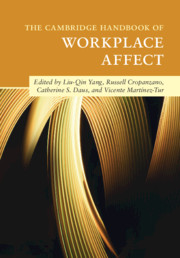Book contents
- The Cambridge Handbook of Workplace Affect
- The Cambridge Handbook of Workplace Affect
- Copyright page
- Contents
- Figures
- Tables
- Contributors
- Foreword
- Part I Theoretical and Methodological Foundations
- Part II Workplace Affect and Individual Worker Outcomes
- Part III Workplace Affect and Interpersonal and Team-Level Processes
- 17 Leadership, Affect, and Emotion in Work Organizations
- 18 Affective Climate in Teams
- 19 Workplace Affect, Conflict, and Negotiation
- 20 Understanding the Role of Affect in Workplace Aggression
- 21 The Service Encounter
- 22 Emotion Work and Emotion Management
- 23 Dynamic Emotional Labor
- Part IV Workplace Affect and Organizational, Social, and Cultural Processes
- Part V Discrete Emotions at Work
- Part VI New Perspectives on Workplace Affect
- Index
- References
23 - Dynamic Emotional Labor
A Review and Extension to Teams
from Part III - Workplace Affect and Interpersonal and Team-Level Processes
Published online by Cambridge University Press: 25 June 2020
- The Cambridge Handbook of Workplace Affect
- The Cambridge Handbook of Workplace Affect
- Copyright page
- Contents
- Figures
- Tables
- Contributors
- Foreword
- Part I Theoretical and Methodological Foundations
- Part II Workplace Affect and Individual Worker Outcomes
- Part III Workplace Affect and Interpersonal and Team-Level Processes
- 17 Leadership, Affect, and Emotion in Work Organizations
- 18 Affective Climate in Teams
- 19 Workplace Affect, Conflict, and Negotiation
- 20 Understanding the Role of Affect in Workplace Aggression
- 21 The Service Encounter
- 22 Emotion Work and Emotion Management
- 23 Dynamic Emotional Labor
- Part IV Workplace Affect and Organizational, Social, and Cultural Processes
- Part V Discrete Emotions at Work
- Part VI New Perspectives on Workplace Affect
- Index
- References
Summary
The past fifty years have seen an increase in the importance of interpersonal processes at work. Growth in the number of customer service jobs has made emotional labor (EL), defined as the management of emotions as part of the work role (Hochschild, 1983), an increasingly important facet of work. Hochschild (1983) argued that EL is a new form of labor, alongside physical and cognitive labor, in which employees regulate their feelings and emotional expressions “in response to job-based emotional requirements in order to produce emotion toward – and to evoke emotion from – another person to achieve organizational goals” (Grandey, Diefendorff, & Rupp, 2013, p. 18). Consistent with theories of emotion, EL has been characterized as a dynamic process that unfolds within individuals over time (Diefendorff & Gosserand, 2003). As a result, empirical research on EL has increasingly focused on testing hypotheses at the within-person level of analysis.
- Type
- Chapter
- Information
- The Cambridge Handbook of Workplace Affect , pp. 310 - 322Publisher: Cambridge University PressPrint publication year: 2020
References
- 5
- Cited by

